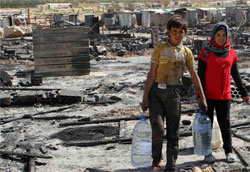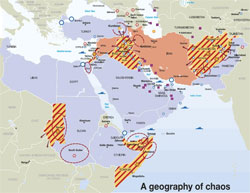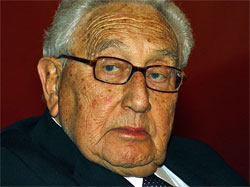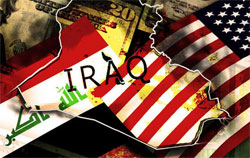A new western policy of chaos? The New Thirty Years’ War of the Middle East
 For years the Middle East is in chaos, each year passes bringing a new set of instability, carnage and suffering for the local population. From Afghanistan to Iraq, Libya to Syria, the western external politics directly generated or amplified the local chaos that we see today and parted to an increased instability course, states Global Research.
For years the Middle East is in chaos, each year passes bringing a new set of instability, carnage and suffering for the local population. From Afghanistan to Iraq, Libya to Syria, the western external politics directly generated or amplified the local chaos that we see today and parted to an increased instability course, states Global Research.
Still a reasonable question of our times is if this instability and destabilization are results of an incompetent strategy of the western nations or a predetermined one in order to intentionally create chaos by balkanizing these nations and to increase intolerance tensions in this region.
The New War
Some personalities from the USA such as Professor Larry Goodson from US Army College of War compare today’s Middle East and the Thirty Years War from 17th century Europe. Even if comparisons between Europe and the Middle East cannot be considered as being precise they became in a way a debate subject in the western geostrategic circles.
The Thirty Years War was a complex historical time where numerous wars and conflicts were held in a series of power blocks for a variety of reasons. In conformity with the Encyclopedia Britannica “although the fights that ignite it began a few years before the conventional war began in 1618 when the future emperor Ferdinand the second of the Holy Roman Empire as the king of Bohemia, tried to impose the Roman Catholic absolutism on his territories but the protestant nobles from Bohemia and Austria rebelled.” The war spread out quickly drawing in the European powers that either thought that there is a possibility of conquering neighboring territories or they were drawn into conflict by a force invading their lands. This war is seen by historians as one of the most destructive times from the European history. Villages and cities were robbed by mercenaries that fought for different power blocks devastating the European continent. The Thirty Years War ended in 1648 by signing a series of treaties known as the Peace of Westphalia establishing a new political order in Europe as the existence of some sovereign states.
In 2007, James Bissett, de ex-ambassador of Canada in Yugoslavia, Bulgaria and Albania considered that the “Westphalian system established the basic principles of sovereignty – the principle of territorial integrity and the principle of non-interfering in the national states’ businesses… Although the Westphalian order was frequently broken, time didn’t derogated this principles”.
 In July 2014 de ex-director of Policy Planning for the United States Department of State and president of the Council on Foreign Relations, Richard Hass compared in his article “The New Thirty Years War” todays Middle East with 17th century’s Europe and previewed that this region will probably be in the future as turbulent as now if a new local order will not be imposed. Recently an idea came along regarding the fact that this “new local order” could be a Middle East Union.
In July 2014 de ex-director of Policy Planning for the United States Department of State and president of the Council on Foreign Relations, Richard Hass compared in his article “The New Thirty Years War” todays Middle East with 17th century’s Europe and previewed that this region will probably be in the future as turbulent as now if a new local order will not be imposed. Recently an idea came along regarding the fact that this “new local order” could be a Middle East Union.
Fragmenting the Middle East
Omnipresent proofs indicate the existence of an agenda with some USA strategies of destroying the nation-states and balkanizing the region setting discord between states, mini-states and micro-states in order to make them so weak and busy fighting, that they can’t unite against de ex colonial powers, especially against the western multinational corporations. After an extended time of destruction and chaos in the area, Middle Eastern peoples could be so fed up with the horrors of war that they would accept a Western imposed order as a way of ending fights, even if the same Western forces are mostly responsible for creating the intolerable existent chaos.
This balkanization strategy can be seen in the recent years at least in the beginning of the 90s when the British-American historian Bernard Lewis wrote an article published in the Foreign Affairs called “Rethinking the Middle East”. He anticipated the dissolving potential of the area through a “chaos of disputes, conflicts, fights between sects, tribes and regions”. Although Lewis wrote in his article that this could be only one of the many possibilities, his presentation today proves to resemble a lot with the situation we observe in countries like Iraq or Libya.
Another possibility that fundamentalism hastes is what lately has become a modern term – “libya-lization”. Most of the Middle Eastern states – Egypt being an obvious exception – are a recent and artificial construction being vulnerable to such a process. If the central power is weak enough and there is no real civil society that keeps running a unitary political system there will be no true feeling of national identity and imperative faith in a nation-state.
Lewis continues: “So the state dissolves – just how it happened in Lebanon – through a chaos of disputes, arguments and fights between sects, tribes, regions and parties. If things go bad and the central government shakes and collapses, this situation could happen not only in the current Middle Eastern countries but in the new independent republics of the ex-Soviet Union where the artificial borders traced by ex-imperial masters left each country with a mosaic of minorities that always claim one thing or another from their neighbors”.
 Two years ago talking at the Ford Institute, de ex United States Secretary of State and Council on Foreign Relations member, Henry Kissinger demystified his desire to see Syria balkanized into many autonomic regions comparing the area with The Thirty Years War in Europe: “There are three possible results: a victory against Assad, a victory of the Sunnis or an end where the different nationalities would agree to coexist but in more or less autonomic areas. This is the result I would like to see… Also, I belie that Assad should go although apparently he is not the key of the problem. The solution resembles to Europe after the Thirty Years War when different Cristian groups killed each other till in the end they admitted to live together but in separate state entities”.
Two years ago talking at the Ford Institute, de ex United States Secretary of State and Council on Foreign Relations member, Henry Kissinger demystified his desire to see Syria balkanized into many autonomic regions comparing the area with The Thirty Years War in Europe: “There are three possible results: a victory against Assad, a victory of the Sunnis or an end where the different nationalities would agree to coexist but in more or less autonomic areas. This is the result I would like to see… Also, I belie that Assad should go although apparently he is not the key of the problem. The solution resembles to Europe after the Thirty Years War when different Cristian groups killed each other till in the end they admitted to live together but in separate state entities”.
Creating a Salafist Principality in Syria
In May this year a series of documents belonging to the USA Department of Defense and the Department of State were discredited in compliance with the Law of free access to information. Amongst it, there was an important document from 2012 belonging to the Defense Information Agency (DIA) that reveals that the western powers, the Gulf and Turkey states supported the Syrian opposition wanting to create a Salafist Principality in eastern Syria to isolate the Syrian regime.
The opposition forces are trying to control the eastern areas (Al-Hasakah and Deir ez-Zor) siding the western provinces of Iraq (Mosul and Al-Anbar) alongside the neighboring borders with Turkey. The western countries, the Gulf States and Turkey support these efforts… If the plan is accomplished there is the possibility of declaring a Salafist Principality in eastern Syria (Al-Hasakah and Deir ez-Zor) and this is exactly what the powers supporting opposition want in order to isolate de Syrian regime considered favorable for the Shia expansion strategy from Iraq and Iran.
The document adds: also ISIS (the Islamic state from Iraq) can thus declare an Islamic state via its union with other terrorist organizations from Iraq and Syria.
Balkanizing Iraq
 Fragmenting Iraq into three separate regions is the objective of many America’s establishment members as early as the 2003 invasion of this country, although Turkey – a NATO member – opposes the build-up of a Kurd state in the north.
Fragmenting Iraq into three separate regions is the objective of many America’s establishment members as early as the 2003 invasion of this country, although Turkey – a NATO member – opposes the build-up of a Kurd state in the north.
In 2006 a possible map of the future Middle East was made public by Lt. Col. Ralph Peters who presented Iraq divided into 3 regions: a Sunni Iraq to the west, a Shia Arab state to the east and a free Kurdistan to the north. Despite the fact that the map does not officially reflect the Pentagon’s Doctrine, it gave us an idea about the way some top military strategists think and it sums up with many other western voices on the strategy for Iraq. As one geopolitical analyst stated in a New Eastern Outlook article in august (2015) and the emeritus president of CFR Leslie Gelb reasoned in a 2003 article for the New York Times the most probable result of the Iraq intervention would be the “solution of the three states: the Kurds to the north, the Sunni in the center and the Shia to the south”.
Syria was portrayed in the mentioned map as still being a unified country because the civil war from this country had not yet begun. Also Israel is presented as having the potential of occupying a larger territory in the following decades.
Different countries, same strategy
The same model of Balkanization and chaos that we see in Iraq and Syria applies to Libya as well. As a result of NATO’s intervention in 2011 in the north-African nation the country fell into abyss and chaos being divided into three parts: Cyrenaica to the east of the country and the west split between Tripolitania to the north-west and Fezzan to the south-west.
Libya is currently considered a failed state lacking a central government and affected by a tribal war where the rival militia that once fought together, are now fighting each other.
The Iranian nuclear agreement could mark a new beginning for the western geopolitical strategists of the Middle East where it could collaborate with the regional powers in order to promote stability and retaining the military interventions. Iranians hope that things will evolve this way and that the Western world will stop the destabilization programs excess that it manages for years.
But the most probable scenario will be a continuation of the Balkanization strategy that we have to expect until a “new local order” will appear – that will be established also by the Western world that will have its own interests.
yogaesoteric
June 2016
Also available in:
 Română
Română
